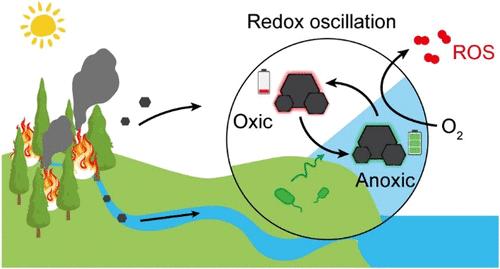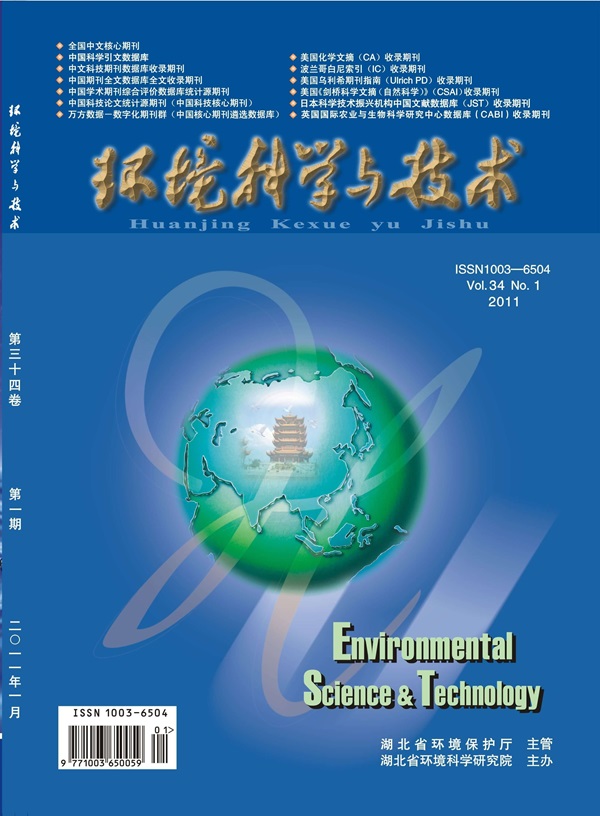氧化还原振荡驱动的黑碳活性氧生成
IF 10.8
1区 环境科学与生态学
Q1 ENGINEERING, ENVIRONMENTAL
引用次数: 0
摘要
野火和秸秆燃烧会向湿地和农田等经常发生氧化还原振荡的自然环境释放大量黑碳(BC)。在这里,我们报告了氧化还原振荡能有效地驱动黑碳产生 ROS。在连续的微生物还原和空气暴露之后,BC 产生了 6.5 ± 0.2 μM/gC 过氧化氢 (H2O2) 和 285.3 ± 9.5 nM/gC 羟基自由基 (-OH)。此外,不同生物质来源、温度和颗粒大小的 BC 产生的 ROS 量相差 111.5 倍。电化学分析表明,电子传递能力和 ROS 生成选择性是氧化还原振荡条件下 ROS 生成的关键决定因素。电子传递能力(0.3-5.7 mmol e-/gC)的变化主要受醌等电子储存分子丰度的影响,而 ROS 生成选择性(26.2-72.0%)则受碳缺陷等氧还原反应竞争位点的影响。这些发现提供了在波动氧化还原条件下 BC 产生 ROS 的见解,对易发生野火和秸秆焚烧事件以及大量 BC 沉积地区(如湿地和稻田)的元素循环和污染物动态具有潜在影响。本文章由计算机程序翻译,如有差异,请以英文原文为准。

Redox Oscillation-Driven Production of Reactive Oxygen Species from Black Carbon
Wildfire and stubble burning release substantial amounts of black carbon (BC) into natural environments that experience frequent redox oscillations, such as wetlands and farmlands. Here, we report that redox oscillations can effectively drive ROS production from BC. Following sequential microbial reduction and air exposure, 6.5 ± 0.2 μM/gC hydrogen peroxide (H2O2) and 285.3 ± 9.5 nM/gC hydroxyl radical (•OH) were produced from BC. Moreover, BC derived from various biomass sources, temperatures, and particle sizes exhibits 111.5-fold variations in ROS production. Electrochemical analyses revealed that both the electron transfer capacity and the ROS production selectivity are critical determinants of ROS generation under redox oscillations. The variation in electron transfer capacity (0.3–5.7 mmol e–/gC) is primarily governed by the abundance of electron-storing moieties such as quinones, while the ROS generation selectivity (26.2–72.0%) is influenced by the presence of competitive sites for oxygen reduction reactions, such as carbon defects. These findings provide insights into ROS production from BC under fluctuating redox conditions, with potential implications for elemental cycles and pollutant dynamics in regions prone to wildfire and stubble burning events and substantial BC deposition (e.g., wetlands and rice paddies).
求助全文
通过发布文献求助,成功后即可免费获取论文全文。
去求助
来源期刊

环境科学与技术
环境科学-工程:环境
CiteScore
17.50
自引率
9.60%
发文量
12359
审稿时长
2.8 months
期刊介绍:
Environmental Science & Technology (ES&T) is a co-sponsored academic and technical magazine by the Hubei Provincial Environmental Protection Bureau and the Hubei Provincial Academy of Environmental Sciences.
Environmental Science & Technology (ES&T) holds the status of Chinese core journals, scientific papers source journals of China, Chinese Science Citation Database source journals, and Chinese Academic Journal Comprehensive Evaluation Database source journals. This publication focuses on the academic field of environmental protection, featuring articles related to environmental protection and technical advancements.
 求助内容:
求助内容: 应助结果提醒方式:
应助结果提醒方式:


